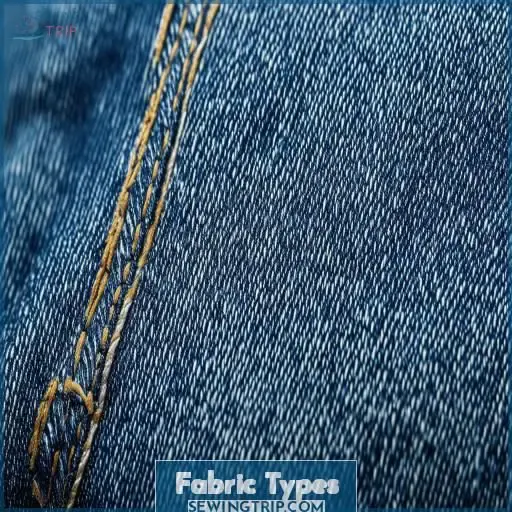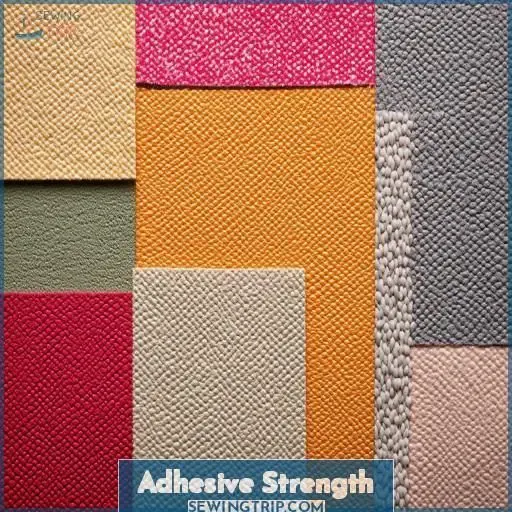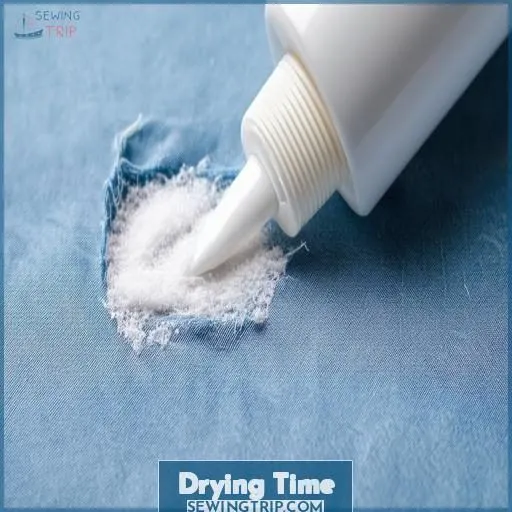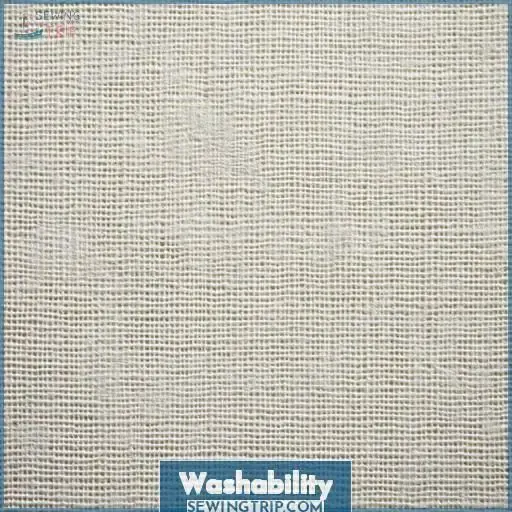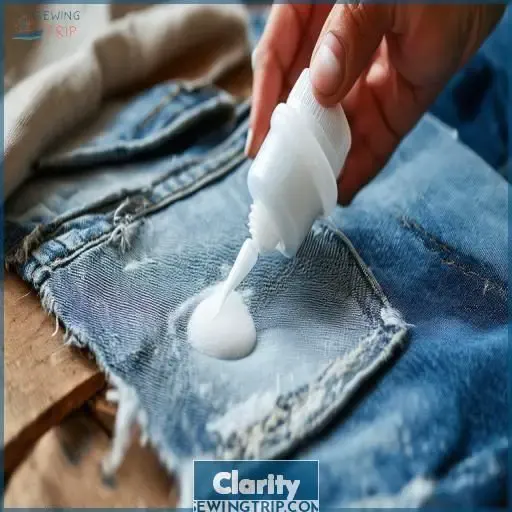This site is supported by our readers. We may earn a commission, at no cost to you, if you purchase through links.
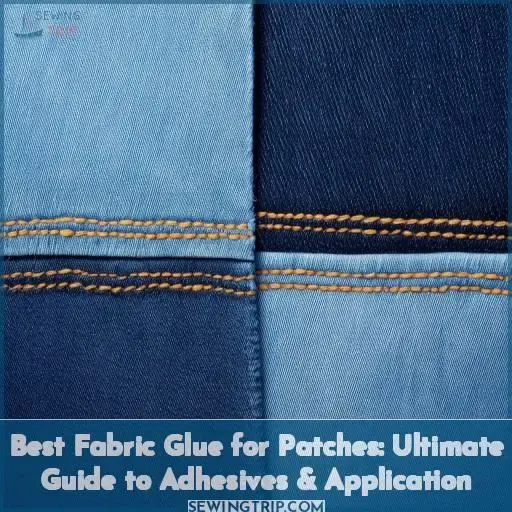 When selecting the best fabric glue for patches, you’ll want to keep in mind the fabric type, desired adhesive strength, and washability needs.
When selecting the best fabric glue for patches, you’ll want to keep in mind the fabric type, desired adhesive strength, and washability needs.
For rigid fabrics like denim or canvas, choose heavy-duty formulas that create a durable bond.
If working with stretchy knits, flexible polymer adhesives allow some give.
Permanent, waterproof options like Liquid Stitch or Fabri-Tac are ideal for machine-washable patches meant to last.
But if you need temporary adhesion for easy removal and readjustment, look for less permanent varieties.
Ultimately, the perfect glue balances strength and flexibility while catering to your project’s specific requirements – keep reading to dive deeper.
Table Of Contents
Key Takeaways
- Match the fabric glue to your patch’s fabric – stiff fabrics need heavy-duty adhesives, while stretchy knits call for some flexibility in the bond. It’s like picking the right dance partner – you want someone who complements your style!
- Consider if you need a permanent bond or temporary hold. Permanent glues are the commitment type, while temporary ones let you play the field a bit. Just don’t string them along!
- Water-resistant formulas are a must if your patched garment might get caught in the rain or take a spin in the washing machine. Nobody likes a soggy, peeling patch – that’s just plain embarrassing.
- Clarity matters too – go for a clear adhesive if you want your fabric’s true colors to shine through, or get a little decorative with a colored glue that adds some pizzazz. It’s like makeup for your clothes!
Fabric Types
You’ll want to choose a fabric glue compatible with your patch and garment materials.
Consider the texture – rigid fabrics like canvas require heavy-duty adhesives, while stretchy knits need flexible formulas that move with the fabric.
Heat resistance is imperative for iron-on patches, so use adhesives designed for high temperatures.
Colorfast is important too – some glues may discolor lighter fabrics.
And durability is key – quality adhesives bond fibers tightly for long-lasting adherence through washing and wear.
With the right glue matched to your fabric types, your patched creations will withstand anything life throws their way.
Adhesive Strength
When selecting the best fabric glue for patches, consider heavy-duty formulas designed for durable bonding on various materials. These strong adhesives often contain flexible polymers that allow some give, preventing the glue from cracking or peeling off as the fabric flexes.
Heavy-Duty Glues
For heavier projects, you’ll need an industrial-grade glue with serious bonding strength. Consider these heavy-duty options:
- Heat-resistant formulas for high-friction areas
- Fast-setting solvent-based adhesives
- Multipurpose glues designed for fabrics and leather
These heavy-duty adhesives create a permanent bond, so apply with care. The right glue guarantees your patches remain in place through wear and tear.
Flexible Formulas
You’ll want a flexible adhesive that can withstand fabric stretching and bending. Check out these options:
| Product | Key Features |
|---|---|
| Liquid Stitch | Permanent, waterproof, machine-washable |
| Fabri-Tac | Flexible, non-toxic, acid-free |
| Aleene’s Fabric Fusion | Flexible bond, machine-washable |
Flexible formulas offer bond durability, heat resistance, and versatility, with some eco-friendly options. Application methods vary – follow product instructions carefully.
Drying Time
When applying fabric glue for patches, you’ll want to think about drying time.
Some formulas cure rapidly, bonding fabrics in minutes, while others take hours to set completely. Rapid-drying options offer convenience, but may limit repositioning time. Slower-drying adhesives allow more flexibility for precise placement before hardening.
Additionally, certain glues require clamping or weighing down materials during the drying phase for a secure bond. Pay attention to manufacturer instructions, as drying times can vary based on fabric type, application technique, and environmental factors like humidity.
With some trial and error, you’ll find the perfect drying window for a seamless, durable patch application.
Washability
When choosing fabric glue for patches, determine whether you require a lasting or temporary adhesive. Permanent options are ideal for patches intended to endure, while temporary formulas allow for easy removal and adjustment if necessary; additionally, water-resistant varieties offer protection from accidental spills or laundering.
Permanent Vs. Temporary
Regarding washability, you can select between permanent or temporary fabric glues. Permanent options create an unbreakable bond:
- Ideal for heirloom pieces
- Never fear patches peeling
- Withstands endless wash cycles
- Costs more but worth the investment
- Perfect for high-wear areas
Temporary adhesives offer flexibility – peel patches off and reapply as needed. Weigh peel strength against your project goals.
Water-Resistant Options
You’ll want a water-resistant fabric glue for patches that withstand moisture and outdoor elements. Consider the versatility of these options:
| Glue Type | Temperature Resistance | UV Resistance | Flexibility | Bond Strength |
|---|---|---|---|---|
| Polyurethane | Excellent | Good | High | Industrial |
| Silicone | Excellent | Excellent | High | High |
| Rubber Cement | Good | Fair | Moderate | Moderate |
Polyurethane and silicone offer superior water, heat, and UV protection for durable, flexible bonds on fabric patches.
Clarity
When choosing a fabric glue for patches, you’ll want to think about the clarity of the adhesive. Clear glues allow the colors and patterns of your fabric to shine through, while colored glues can provide a unique, decorative touch to your patch application.
Clear Glues
Regarding clarity, you’ll find fabric glues with a transparent, gel-like consistency suitable for intricate applications. These allow you to place patches or appliques accurately without concerns about visible imperfections. Clear adhesives are ideal for lighter fabrics or colored materials where a discreet bond is crucial. Consider specialized formulas with extended tack times for detailed craft projects.
Colored Glues
You might opt for colored fabric glues for a more decorative touch. They can be matched to your project’s color scheme or dye. Look for these 3 qualities:
- UV resistance
- Sheen or matte finish
- Stain-resistant formula
Colored glues offer versatility while adding a subtle design element. Just be mindful of bleed-through on lighter fabrics.
Frequently Asked Questions (FAQs)
How long does the fabric glue last?
The lifespan of fabric glue varies from 6 months to a year after opening. However, properly stored and unopened, it can last up to 2-3 years. For the best results, check the expiration date and test a small area before applying it to your patches.
Is the glue safe for kids clothing?
Yes, fabric glues are generally safe for kid’s clothing if non-toxic and properly cured. Always check the product label and allow sufficient drying time before wear. Consider fabric-friendly adhesives designed for apparel use for extra precaution.
Can the glue be used on leather?
A gentle fabric adhesive blooms on leather, bonding patches seamlessly. Its flexibility allows the garment’s natural movements, preventing cracks or peeling over time. Yes, you can use the right fabric glue on leather with proper preparation.
Does the glue leave any residue behind?
Yes, quality fabric glues can leave some residue behind if not applied properly. To minimize this, follow the manufacturer’s instructions carefully and avoid over-applying the glue. With proper technique, residue can be kept to a minimum.
How do you remove the fabric glue?
Oh boy, fabric glue can be a stubborn little beast!
First, try soaking the area with warm water and some dish soap. Let it sit for a bit.
Then, gently scrape away with a dull knife or brush.
If that won’t do the trick, you may need to enlist some rubbing alcohol or even nail polish remover to dissolve that sticky mess.
Conclusion
Traversing the fabric adhesive aisle, you’re equipped to selectively choose the best fabric glue for patches.
Like a reliable guide directing your crafting expedition, understanding fabric types, adhesive strengths, drying times, washability, and clarity will guarantee your patches adhere effortlessly.
Armed with this knowledge, you can assuredly create enduring or ephemeral designs customized to your vision.
Enhancing every project with professional-grade outcomes.

